data-harmonizer v1.6.5
DataHarmonizer
A standardized browser-based spreadsheet editor and validator that can be run offline and locally, which works of of LinkML data specifications. This open source project, created by the Centre for Infectious Disease Genomics and One Health (CIDGOH) at Simon Fraser University, is now a collaboration with contributions from the National Microbiome Data Collaborative (NMDC), the LinkML development team, and others. Read the open-source DataHarmonizer manuscript for more about the application's theory and design.
Watch Rhiannon Cameron and Damion Dooley describe this application on YouTube at the Canadian Research Software Conference (CRSC2021).
| Chrome | Firefox | Edge |
|---|---|---|
| 49+ | 34+ | 12+ |
Pathogen Genomics Templates
Note that the Pathogen Genomics Package of DataHarmonizer templates, which includes Covid-19 and Monkeypox, is available now as a simpler stand-alone zip file at https://github.com/cidgoh/pathogen-genomics-package. This version does not require the use of the developer environment and can be run simply by loading the index.html or main.html files in your local web browser.
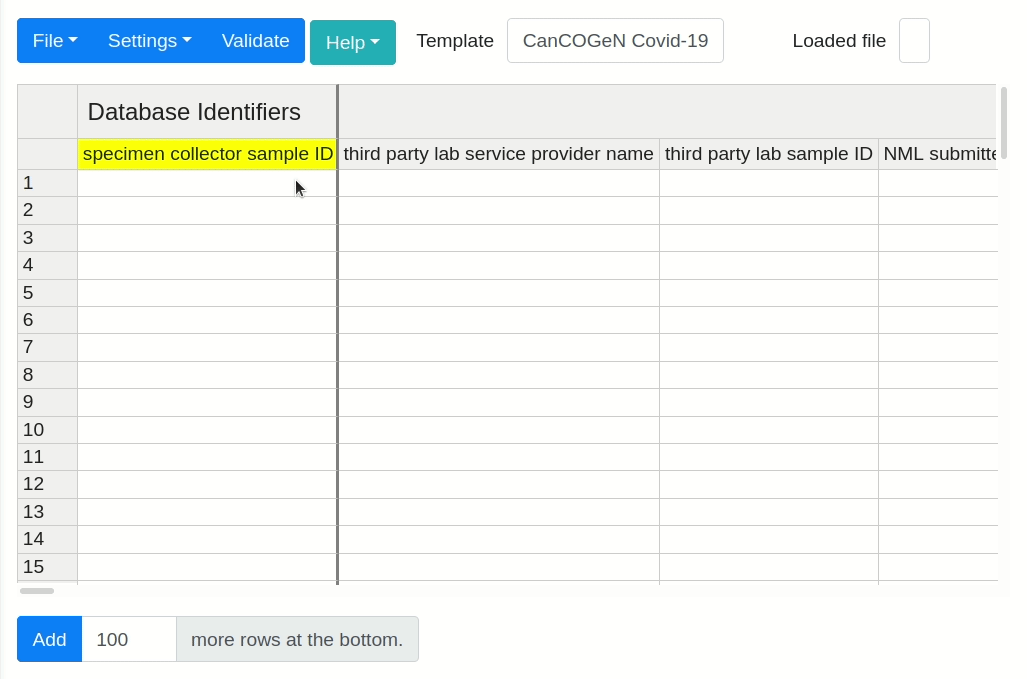
Manuscript
The DataHarmonizer: a tool for faster data harmonization, validation, aggregation and analysis of pathogen genomics contextual information
Microbial Genomics (9:1) 2023
DOI: https://doi.org/10.1099/mgen.0.000908
Ivan S. Gill, Emma J. Griffiths, Damion Dooley, Rhiannon Cameron, Sarah Savić Kallesøe, Nithu Sara John, Anoosha Sehar, Gurinder Gosal, David Alexander, Madison Chapel, Matthew A. Croxen, Benjamin Delisle, Rachelle Di Tullio, Daniel Gaston, Ana Duggan, Jennifer L. Guthrie, Mark Horsman4, Esha Joshi, Levon Kearny, Natalie Knox, Lynette Lau, Jason J. LeBlanc9, Vincent Li, Pierre Lyons, Keith MacKenzie1, Andrew G. McArthur, Emily M. Panousis, John Palmer, Natalie Prystajecky, Kerri N. Smith, Jennifer Tanner, Christopher Townend, Andrea Tyler, Gary Van Domselaar, William W. L. Hsiao
Installation
This repository contains a full DataHarmonizer development environment including the scripts necessary to generate a code library for API use, as well as the stand-alone version. Instructions for setting this up is in the Development section below. The API is used by the https://data.microbiomedata.org/ project for data collection. Using the API allows DataHarmonizer to be presented in a custom user interface, with a specific template pre-loaded for example, and select controls menu items constructed as desired in the interface.
Stand-Alone DataHarmonizer Functionality
In addition to API use, as detailed in the Development section, the development environment includes a script for generating a stand-alone browser-based version of DataHarmonizer that includes templates for detailing SARS-CoV-2 and Monkeypox sample contextual data. More infectious disease templates will be included in the comming year. Other organizations are adopting this version of DataHarmonizer for their own data management purposes.
Select Template
The default template loaded is the "CanCOGeN Covid-19" template. To change the spreadsheet template, select the white text box to the right of Template, it always contains the name of the template currently active, or navigated to File followed by Change Template. An in-app window will appear that allows you to select from the available templates in the drop-down menu. After selecting the desired template, click Open to activate the template.
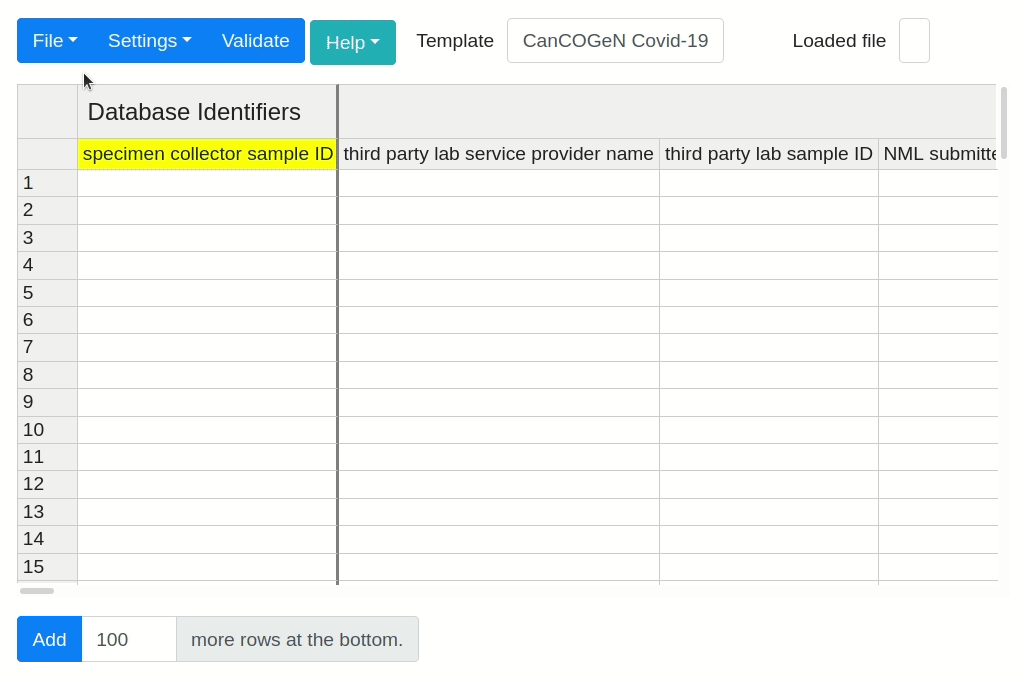
A second way to access templates directly, rather than by the hard-coded menu system, is to specify the DataHarmonizer template subfolder via a "template" URL parameter. This enables development and use of customized templates, or new ones, that DH doesn't have programmed in menu.
For example, http://genepio.org/DataHarmonizer/main.html?template=gisaid accesses the /template/gsiaid/ subfolder's template directly.
See more on the Wiki DataHarmonizer templates page.
Usage
You can edit the cells manually, or upload xlsx, xls, tsv, csv and json files via File > Open. You can also save the spreadsheet's contents to your local hard-drive in the aforementioned formats, or File > Export your data as a document formatted for submission a specified portal, database, or repository.
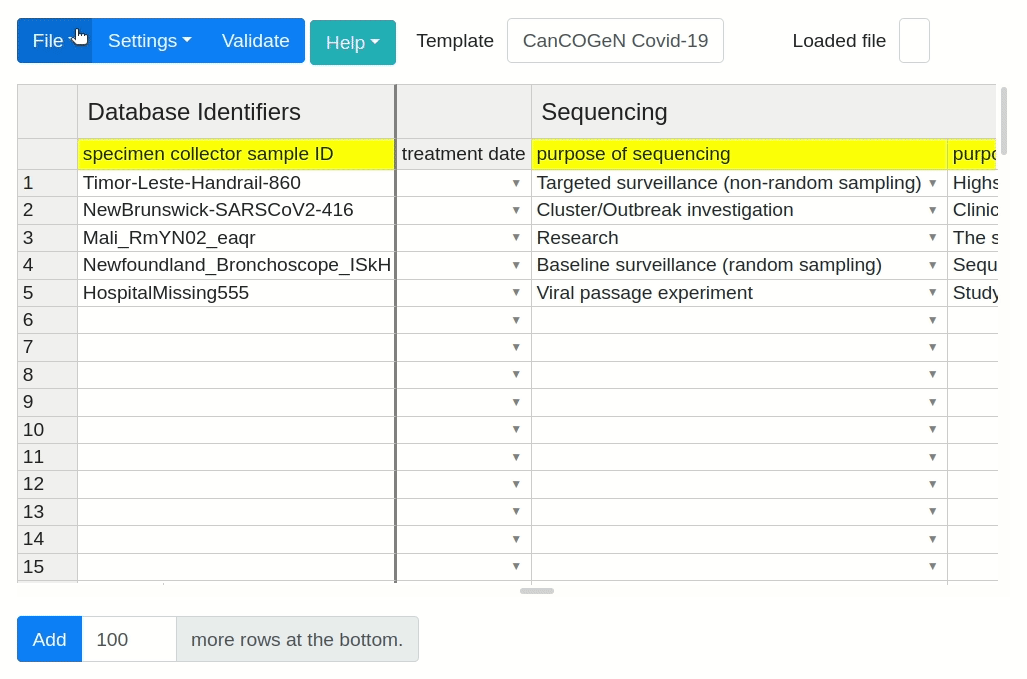
Click the Validate button to validate your spreadsheet's values against a standardized vocabulary. You can then browse through the errors using the Next Error button. Missing value are indicated in dark red, while incorrect values are light red. After resolving these errors, revalidate to see if any remain. If there are no more errors the “Next Error” button will change to “No Errors” and then dissapear.
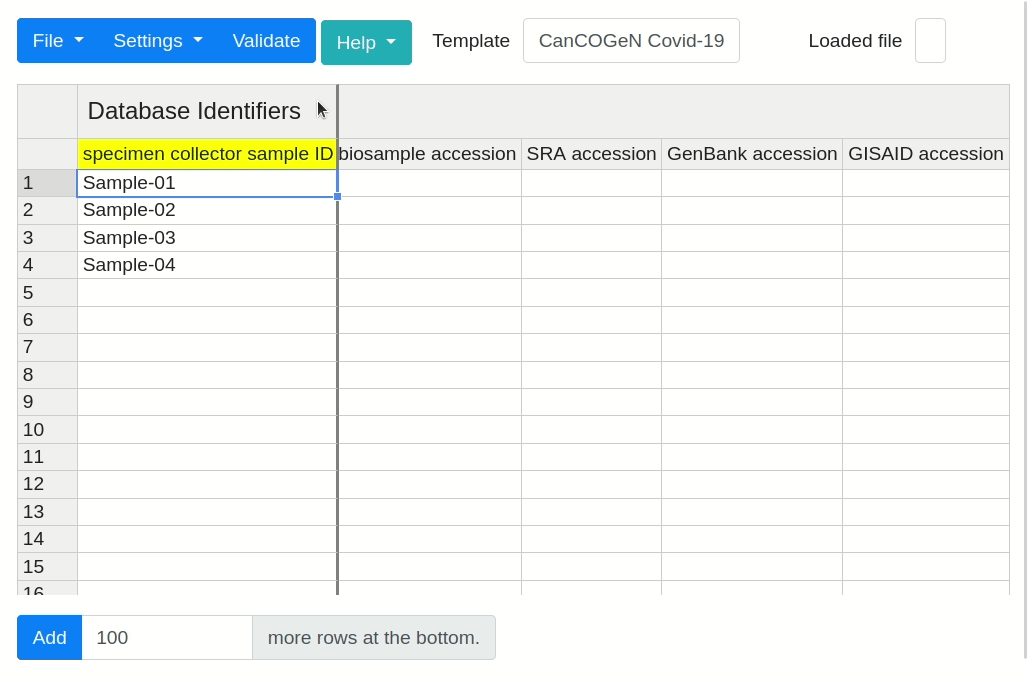
Double click any column headers for information on the template's vocabulary. This usually includes the definition of the field, guidance on filling in the field, and examples of how data might look structured according to the constraints of the validator.
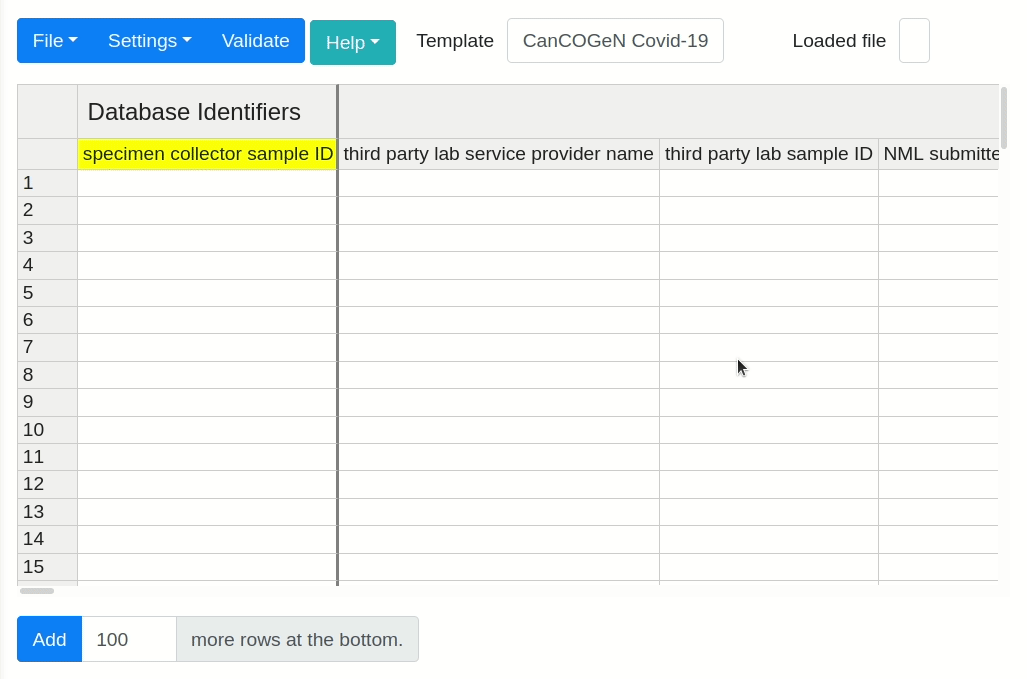
You can quickly navigate to a column by selecting Settings > Jump to.... An in-app window will appear, select the desired column header from the drop-down list or begin typing its name to narrow down the list options. Selecting the column header from the drop down list will immediately relocate you to that column on the spreadsheet.
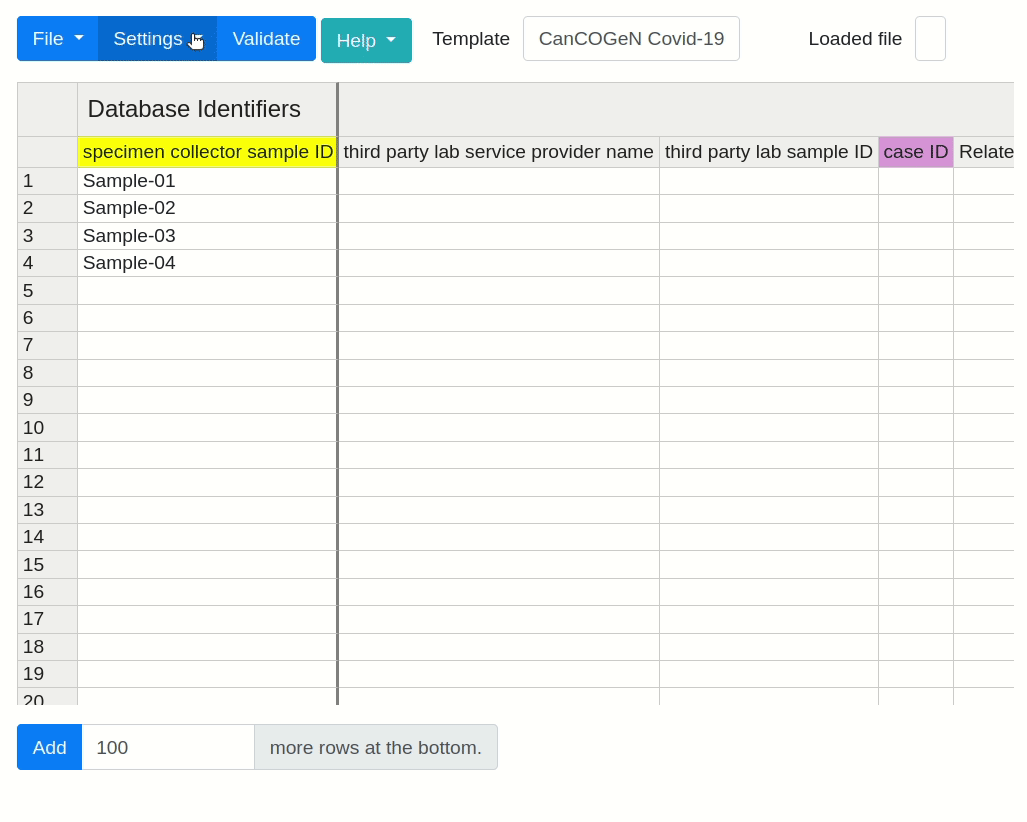
You can also automatically fill a column with a specified value, but only in rows with corresponding values in the first sample ID column. To use this feature select Settings > Fill column.... Select the desired column header from the drop-down list or begin typing its name to narrow down the list options, then specify the value to fill with and click Ok to apply.
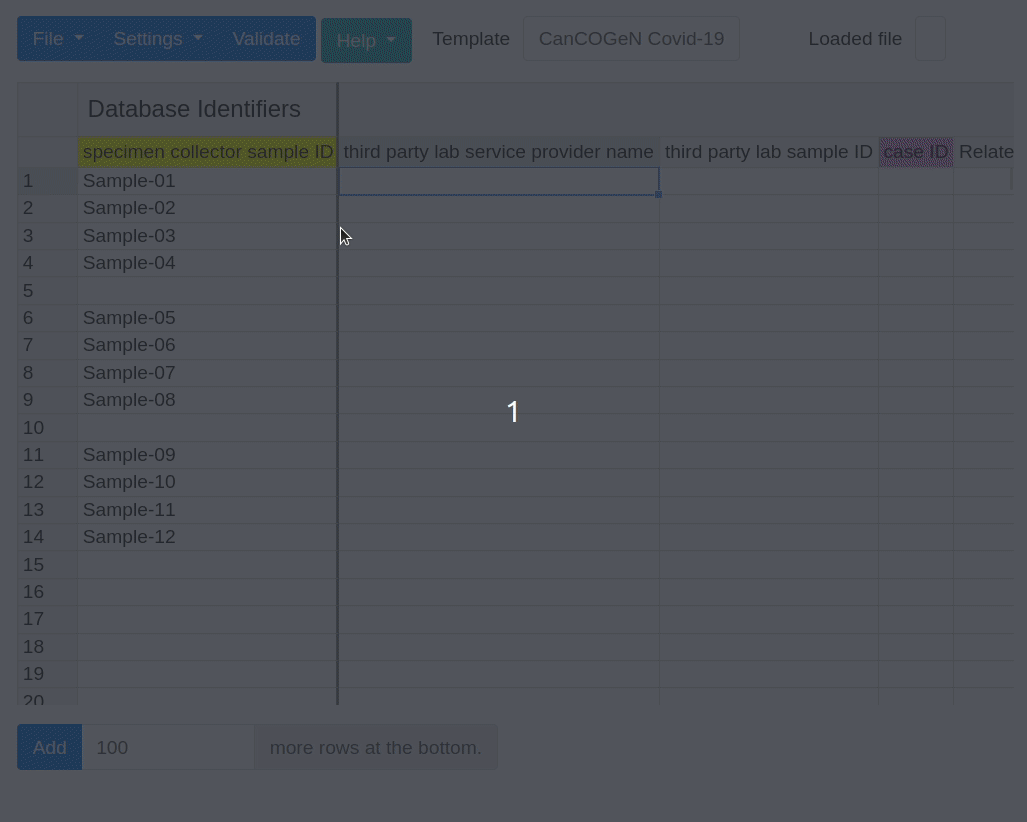
For more information on available application features, select the Help button followed by Getting Started from within the DataHarmonizer application or navigate to the Getting Started GitHub wiki..
Example Data
The stand-alone version of DataHarmonizer when built is placed in the /web/dist/ folder, with the following structure. Templates with example data testing functionalities can be found within the following folder structure leading to the "exampleInput/" folder, when available:
. TOP LEVEL DIRECTORY
├── images
├── libraries
├── script
└── template
│ ├── templateOfInterest
│ │ └── exampleInput
│ └── ...Note that the source of the built "template/" folder above is actually in /web/templates/, where example input data should be placed before performing the build process. Here is an example that links to all available test data for the CanCOGeN Covid-19 template:
canada_covid19CanCOGeN Covid-19
Version Control
Versioning of templates, features, and functionality is modeled on semantic versioning (i.e. versions are expressed as “DataHarmonizer X.Y.Z”). Changes to vocabulary in template pick lists are updated by incremental increases to the third position in the version (i.e. “Z” position). Changes to fields and features are updated by incremental increases to the second position in the version (i.e. “Y” position). Changes to basic infrastructure or major changes to functionality are updated by incremental increases to the first position in the version (i.e. “X” position).
Descriptions of updates are provided in release notes for every new version.
Discussions contributing to updates may be tracked on the DataHarmonizer GitHub issue tracker.
Development
Code in this repository is split mainly between two folders: lib and web. The lib folder contains the core interface components which are published to NPM and can be used by any client to build a user interface. The web folder contains an implementation of one such interface, using the components defined in lib. The interface implemented in the web folder is packaged and made available to users as releases of this repository.
Prerequisites
For development, you must have Node.js and Yarn installed. If you have Node.js version 16.10 or later (highly recommended) and you have not used Yarn before, you can enable it by running:
corepack enableInstalling
To install the dependencies of this package for development simply run:
yarnRunning Locally
Developing either the library components in lib or the interface in web can be done using the same command:
yarn devThis will start a webpack development server running locally on localhost:8080. You can connect to localhost:8080 by inputing it into your browser URL bar while yarn dev is running. Changes to either lib or web should be loaded automatically in your browser. This serves as interface for testing and debugging the core library components (in the lib directory) and that interface itself (the web directory).
Publishing and Releasing
To bundle the canonical interface run:
yarn build:webYou can open web/dist/index.html in your browser to test the distributable bundle and verify it runs in "offline".
To bundle the library components into lib/dist for downstream clients to use via API instead of the canonical interface, run:
yarn build:libMaking templates
With a [schema name] of your choice, work in /web/templates/[schema name]/
- Add one almost empty file
export.jsto the same folder. It contains:
// A dictionary of possible export formats
export default {};Assemble one
schema.yamlfile by hand. It should be a merger of a valid linkmlschema.yamlfile (your existing schema) and at least an extradh_interfaceclass. Thedh_interfaceclass signals to DH to show the given class as a template menu option. Below we are using an AMBR class as an example:
classes:
dh_interface:
name: dh_interface
description: A DataHarmonizer interface
from_schema: https://example.com/AMBR # HERE CHANGE TO [schema name] URI
AMBR: # HERE CHANGE TO [schema name]
name: AMBR
description: The AMBR Project, led by the Harrison Lab at the University of Calgary,
is an interdisciplinary study aimed at using 16S sequencing as part of a culturomics
platform to identify antibiotic potentiators from the natural products of microbiota.
The AMBR DataHarmonizer template was designed to standardize contextual data
associated with the isolate repository from this work.
is_a: dh_interface- Optionally add all the
types: {}from one of the other specificationschema.core.yamlfile examples existing in/web/templates/, since this allows DH things like the "provenance" slot, and allows use of thewhitespaceMinimizedStringdatatype which blocks unnecessary spaces, but this is not essential.
types:
WhitespaceMinimizedString:
name: 'WhitespaceMinimizedString'
typeof: string
description: 'A string that has all whitespace trimmed off of beginning and end, and all internal whitespace segments reduced to single spaces. Whitespace includes #x9 (tab), #xA (linefeed), and #xD (carriage return).'
base: str
uri: xsd:token
Provenance:
name: 'Provenance'
typeof: string
description: 'A field containing a DataHarmonizer versioning marker. It is issued by DataHarmonizer when validation is applied to a given row of data.'
base: str
uri: xsd:token- Generate the
schema.jsonfile in that file’s template folder (/web/templates/[schema name]/) by running
python ../../../script/linkml.py -i schema.yamlThis will also add a menu item for your specification by adjusting /web/templates/menu.json.
- Check the updated
/web/templates/menu.json. With this example, the template menu will be "ambr/AMBR".
"ambr": {
"AMBR": { # Make sure the right class is called by DH
"name": "AMBR",
"status": "published",
"display": true # Make sure the status is set to true
}- Test your template, by going to the DH root folder and type (as documented on github main code page):
yarn devYou can then browse to http://localhost:8080 to try out the template.
- you can then build a stand alone set of JS files in
/web/dist/
yarn build:webThe /web/dist/ folder can then be zipped or copied separately to wherever you want to make the app available.
TODO: describe how to use the DataHarmonizer javascript API.
Roadmap
This project is now in production, with new features being added occasionally. The Projects tab indicates anticipated functionality.
Support
If you have any ideas for improving the application, or have encountered any problems running the application, please open an issue for discussion.
Additional Information
For more information about the DataHarmonizer, it's templates, and how to use them, check out the DataHarmonizer Wiki.
Acknowledgement
- Handsontable was used to build the grid. DataHarmonizer is configured to reference the "non-commercial-and-evaluation" handsontable license "for purposes not intended toward monetary compensation such as, but not limited to, teaching, academic research, evaluation, testing and experimentation"; if this application is used for commercial purposes, this should be revised as per https://handsontable.com/docs/license-key/
- SheetJS was used to open and save local files. The community edition was used under the Apache 2.0 license.
License
DataHarmonizer javascript, python and other code not mentioned in the Acknowledgement above is covered by the MIT license.